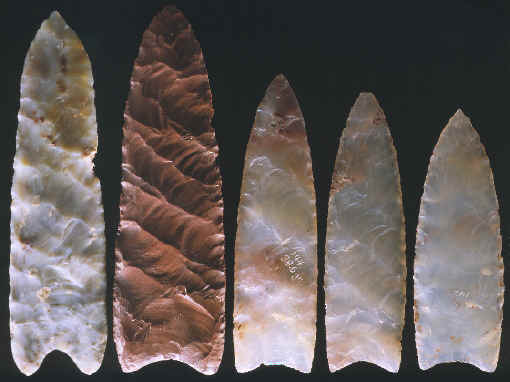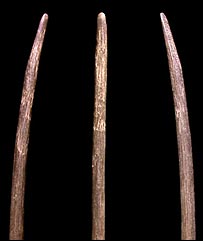 | Go to Calendar page
|
|

![]()
The Solutrean Culture
Look at How Far We Have Come
 |
|||||||
W
ere the earliest inhabitants of the New World from Siberia, Japan – or Stone Age France?When the world was still in the grip of the last ice age some 15,000 years ago, an intrepid group of Stone-Age mammoth hunters tracked their prey over the bleak Arctic tundra. Crossing the stretch of land which then connected Siberia to Alaska, these early pioneers thereby became the first people to set foot in the New World.
Or did they?
This romantic image of the first Americans has captivated archaeologists for almost a century, but in the last few years it has started to give way to a very different picture. Thousands of years ago America may already have been a melting pot of ethnic groups from across the Pacific, north-east Asia, and even Europe.
 |
|
Clovis points |
During the next 60 years, purportedly pre-Clovis artifacts kept turning up, only to be swiftly knocked down again. The Clovis story was elegant and stood the test of time. And yet some awkward sites remained; none more so than Monte Verde in south central Chile. In 1977, University of Kentucky archaeologist Thomas Dillehay began excavating this ancient settlement, which had been remarkably preserved under a blanket of peat. Radiocarbon dating fixed the site at 14,850 years old, centuries before the Clovis had even begun their trek southward.
For over a decade Dillehay battled to be heard over the so-called "Clovis Mafia", a group of powerful and intransigent defenders of the Clovis-first idea. When a group of die-hard skeptics finally visited Monte Verde in 1997, they had to admit that the date was right, thus precipitating a storm in the archaeology community. If the Clovis were not the first Americans, who were? And where did they come from, how did they get there, and when did they arrive?
Dozens of possibilities have since been put forward, and while no two scientists have the same answer, they agree that this is an exciting time to be in the field.
Ruth Gruhn of the University of Alberta, Canada, says that although Monte Verde was the turning point, dozens of lesser-known pre-Clovis sites in South America should have made it obvious long ago that Clovis were not the first.
At Quebrada Jaguay on the coast of southern Peru, for example, a small fishing village seems to have been in existence 13,025 years ago – a time when the Clovis were still throwing spears in north America.
![]()
Although some specialists still doubt the significance of Monte Verde, the many archaeologists now expressing strong doubts about the Clovis-first theory are not alone. Canadian geologists have been saying for years that the so-called "ice-free corridor" was more of a "huge impassable lake" right up until the end of the Clovis period. And anthropologists have noticed something strange about the handful of really ancient American skulls so far unearthed – they don't look anything like modern Native Americans. Instead, they resemble Polynesians or Ainu – an isolated ethnic group in northern Japan who look quite unlike modern Japanese.
"There was considerable diversity among the early people; they were much more diverse than Native Americans today. So somehow that diversity was reduced,"
says Richard Jantz, the University of Tennessee anthropologist who has been studying these ancient crania.
Jantz is one among a growing number of people who believe that the earliest Americans may have come from Japan. Thousands of years later Siberians colonised America, which explains why modern Native Americans and Siberians look alike. Jantz admits that right now this is just one of several different scenarios.
However new Stone-Age artifacts from frozen deposits on an ancient terrace by the Yana River in northern Siberia indicate the presence of humans in the Arctic to around 30,000 years ago. The site is about 500 kilometres above the Arctic Circle. The artifacts found at the Yana River valley date to a time when the climate was cooling down, and transforming open meadows into icy tundra.

Recent DNA analysis also suggests that the Clovis were probably not the first people to have found their way to America. Theodore Schurr of the Southwest Foundation for Biomedical Research in San Antonio, Texas, has compared mitochondrial DNA from modern Native Americans with that from people from all over the globe. Schurr says that it looks from the DNA as though ancient Siberians crossed into the continental interior as far back as 40,000 years ago. Then, some time between 15,000 and 30,000 years ago, they were joined by groups from Japan and possibly even Europe.
![]()
The study added more evidence to an ancient asian migration route. A mutation called haplotype M242 is present in both Central Asian and American populations. It originated after haplotype M45/M74 mutations, which both arose 40,000 years ago in Asia; but before the haplotype M3 mutation, which first arose in the Americas: It was this M242 mutation that was calculated to have occurred at a maximum date of 18,000 years ago. The researchers used an approximate rate at which DNA on the Y chromosome mutates, and the time taken for a single male generation.
![]()
Valuable though it is, DNA says nothing about how people might have got from Japan or Europe to America. Early navigators did travel by sea to Australia around 50,000 years ago, but no one is seriously suggesting that Stone-Age men and women sailed across the open oceans. A coastal route from Japan to north-west America, however, now looks reasonable. Anthropologist Dennis Stanford of the Smithsonian Institution in Washington DC says he can trace Clovis culture straight back to the Stone-Age Solutrean culture of Spain.
In the DNA profile of the Ichigua Native American tribe he identified a lineage that was clearly European in origin, too old to be due to genetic mixing since Columbus' discovery of the New World. Instead it dated to Solutrean times. The genetic timelines show the Ice Age prompted a number of migrations from Europe to America. It looks highly likely that the Solutreans were one.
While most of northern Europe and Canada were under ice sheets, argues Stanford, these ancient Solutreans could simply have followed the sea-ice round the north Atlantic and down to the north-east coast of America.
The Solutrean, which is named after the site of Solutré, near Mâcon (Saône-et-Loire), is noted for the beautifully made, symmetrical, bifacially flaked, laurel-leaf, and shouldered points, the finest examples of flint workmanship of the Paleolithic in western Europe. In addition, the usual types of gravers, end scrapers, points, perforators, etc., are present. Examples of Solutrean art are comparatively rare; they consist of sculpture in low relief and incised stone slabs. The fauna indicates that this culture flourished in a relatively cold climate.
Solutrean Industry was a short-lived style of tool making that flourished approximately 17,000 to 21,000 years ago in southwestern France (e.g., at Laugerie-Haute and La Solutré) and in nearby areas. The industry is of special interest because of its particularly fine workmanship. The Solutrean industry, like those of other late Paleolithic big-game hunters, contained a variety of tools such as burins (woodworking tools rather like chisels), scrapers, and borers; but blades that were formed in the shape of laurel or willow leaves and shouldered points are the implements that distinguish the Solutrean.
In the early Solutrean, unifacial points (flaked on only one side) are common. In the middle Solutrean, these are gradually replaced by laurel-leaf blades and bifacial points. Tiny blunt-backed flint blades and scrapers and single-shouldered points also occur. Bizarre implements, with notches or asymmetrical shapes, appear; these and laurel-leaf blades so fine as to have precluded their use as tools suggest the production of fine-flaked implements for purposes of luxury alone. In the late Solutrean, the willow-leaf blade (slim, with rounded ends and retouching on one side only) of extremely fine workmanship made its appearance. Bone needles with eyes occur and indicate the use of fitted clothing, useful in a near-glacial climate. There is much evidence of the use of ornament: bracelets, bead necklaces, pendants, bone pins, and coloured pigments must have been used for personal adornment. Stone friezes, bas-reliefs, and paintings on stone plaques and cave walls are known. Even tool stone was chosen for its beauty; coloured quartz, jasper, and handsome flints abound.
The origin of the Solutrean stone-working technique is in some dispute. Most of the evidence indicates it was an invention indigenous to the Dordogne region of France, but some scholars attribute its swift appearance to the arrival of a new people and its equally swift disappearance to destruction of the Solutrean people by another group arriving with a different tool industry. The Solutrean follows the Perigordian and Aurignacian industries and is succeeded by the Magdalenian.
![]()
Solutrean culture ended thousands of years before Clovis began, but there are tantalising suggestions of intermediate sites that bridge the two cultures, in both time and technology. One is in Cactus Hill, Virginia:
"The artifacts are such that if you found them with Solutrean you wouldn't pay any attention to them, but they're not quite Clovis. So I think that makes a nice, neat progression, Our stereotype of the caveman is just bunk. These Solutrean guys survived the ice age and were very ingenious. They were not guys with clubs wearing bearskin cloaks."
 |
|
The Sage |
From his studies of hunter-gatherer communities – and his first-hand experience as a merchant marine in Alaska – Everett Bassett, an anthropologist at the University of Utah, concludes that people only turn to a maritime way of life when they are under extreme stress, because fishing is risky and ties you down.
"Everything Dennis [Stanford] says is possible, but from what we know about the kinds of economic decisions people make, it's unlikely."
Any archaeological evidence that would suggest otherwise is now, sadly, under water. If it were ever to resurface, it could answer one of the most intriguing mysteries of human migration.
![]()
| Archaeologists |
from the University of South Carolina on 17th November 2004 announced radiocarbon tests that dated the first human settlement at the `Topper dig site` along the Savannah River in North America to 50,300 years ago -- at least 25,000 years before other known human sites on the continent.
"Topper is the oldest radiocarbon dated site in North America." A 2 feet wide fire pit showed that oak, pine, red cherry and buckeye wood had been burned in a low-temperature fire at least 50,300 years ago. The burnt layer measuring 2 - 3 inches had the "shape of a very shallow plate", and could have been the result of a fire tended by humans. But it is also possible that the ashes could have been deposited by wind, rain or flooding. Many scientists thought humans first ventured into the New World across a land bridge from present-day Russia into Alaska about 13,000 years ago. This new discovery suggests humans may have crossed the land bridge into the Americas much earlier -- possibly during an ice age -- and rapidly colonized the two continents. "It poses some real problems trying to explain how you have people arriving in Central Asia almost at the same time as people in the Eastern United States.” Conclusive evidence of stone tools similar to those in Asia and uncontaminated radiocarbon dating samples are needed to verify that the Topper site is actually 50,000 years old. "If dating is confirmed, then it really does have a significant impact on our previous understanding of New World colonization.," But not all scientists are convinced that what Goodyear found is a human settlement. This discovery leads archaeologists to support alternative theories -- such as settlement by sea -- for the Americas. |